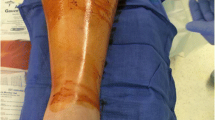Abstract
Intramedullary nailing is the “gold standard” in the treatment of shaft tibial fractures. It provides high rates of bone healing. We analyzed the advantages of intramedullary nailing using a suprapatellar approach, which reduces the risk of DVT and makes patient management in the operating room easier.








Similar content being viewed by others
Bibliografia
Salvo GC, Longo G (2009) Lo Scalpello-Otodi Educ 22(3):165–169
Lang GJ, Cohen BE, Bosse MJ, Kellam JF (1995) Proximal third tibial shaft fractures. Should they be nailed? Clin Orthop Relat Res 315:64–74
Toivanen JA, Väistö O, Kannus P et al. (2002) Anterior knee pain after intramedullary nailing of fractures of the tibial shaft. A prospective, randomized study comparing two different nail-insertion techniques. J Bone Jt Surg Am 84-A(4):580–585
Archdeacon MT (2009) Problem specific entry portals for lower extremity IM nailing. AAOS Now. http://www.aaos.org/news/aaosnow/may09/research6.asp
Morandi M, Banka T, Gaiarsa GP et al. (2010) Intramedullary nailing of tibial fractures: review of surgical techniques and description of a percutaneous approach. Orthopedics 33(3):172–179
Kutty S, Laing AJ, Prasad CV, McCabe JP (2005) The effect of traction on compartment pressures during intramedullary nailing of tibial-shaft fractures. A prospective randomised trial. Springer Int Orthop 29(3):186–190
Väistö O, Toivanen J, Paakkala T et al. (2005) Anterior knee pain after intramedullary nailing of a tibial shaft fracture: an ultrasound study of the patellar tendons of 36 patients. J Orthop Trauma 19(5):311–316
Jones M, Parry M, Whitehouse M, Mitchell S (2014) Radiologic outcome and patient-reported function after intramedullary nailing: a comparison of the retropatellar and infrapatellar approach. J Orthop Trauma 28(5):256–262
Tornetta P III, Collins E (1996) Semiextended position of intramedullary nailing of the proximal tibia. Clin Orthop Relat Res 328:185–189
Beltran MJ, Collinge CA, Patzkowski JC et al. (2012) Intra-articular risks of suprapatellar nailing. Am J Orthop 41(12):546–550
Sanders RW, DiPasquale TG, Jordan CJ et al. (2014) Semi-extended intramedullary nailing of the tibia using a supra-patellar approach: radiographic results and clinical outcomes at a minimum of 12 months follow-up. J Orthop Trauma 28(5):245–255
Conflitto di interesse
Nessuno.
Author information
Authors and Affiliations
Corresponding author
Rights and permissions
About this article
Cite this article
Salvo, G.C., Bonfiglio, S. & Longo, G. Inchiodamento tibiale con accesso sovrarotuleo mininvasivo. LO SCALPELLO 28, 214–218 (2014). https://doi.org/10.1007/s11639-014-0083-7
Published:
Issue Date:
DOI: https://doi.org/10.1007/s11639-014-0083-7




